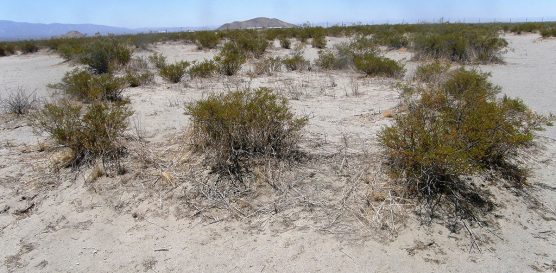 If you take a trip to or through the desert, you will likely see this plant as you drive down the road. Most people can identify it – the creosote bush (Larrea tridentata), otherwise known as greasewood. The creosote bush is a flowering medicinal herb that is a prominent species in the Mojave and Sonoran deserts of California and other desert regions in the Southwest.
If you take a trip to or through the desert, you will likely see this plant as you drive down the road. Most people can identify it – the creosote bush (Larrea tridentata), otherwise known as greasewood. The creosote bush is a flowering medicinal herb that is a prominent species in the Mojave and Sonoran deserts of California and other desert regions in the Southwest.
What most people probably do not know is that some of these plants can be centuries old. As the creosote bush grows older, its oldest branches eventually die, and its crown splits into separate crowns or rings, with later growth expanding outward from the main center point. This usually happens when the plant is about 30 to 90 years old. Eventually, the old crown dies, and the new one becomes a clonal colony from the previous plant.
The clonal colony is made up of a group of genetically identical plants that have grown in a location, which all originated vegetatively and not sexually from a single ancestor. What this means is that the individual plants in the colony reproduce underground from one common plant, rather than from separate seeds. Above ground, these plants appear to be distinct individuals, but underground they remain interconnected and are all clones of the same plant.
Creosote bush rings are considered rare and “sensitive” by federal and state agencies and scientific communities, but they have not been given the protection of the state or federal endangered species acts. The Bureau of Land Management has chosen to protect a fairly large concentration of these rings in an area called the Soggy Dry Lake Creosote Rings Area of Critical Environmental Concern (ACEC). This area is located east of Lucerne Valley and north of Highway 247 and abuts the Johnson Valley Off Highway Vehicle Area.
The BLM designated the Soggy Dry Lake Creosote Rings ACEC to protect the largest known creosote rings on public lands administered by the federal government. The rings of creosote within the area have recently been identified as the world’s oldest living plant; some are estimated to be about 10,000 years old. Even the average age of individual creosote bushes in this area is likely well over 600 years old.

King Clone
King Clone is believed to be the oldest creosote bush ring; it is estimated to be about 11,700 years old, which makes it one of the oldest living organisms on Earth. King Clone reaches about 67 feet in diameter with an average diameter of 45 feet. It is in an area that is fenced off with a barbless wire, but there are no signs prohibiting entry by foot. Somewhat surprisingly, there are also no signs or anything that would suggest anything important exists within the area.
Not only are creosote bush rings incredibly old; their contribution to our global carbon sequestration is only recently becoming more fully understood and appreciated. (Carbon sequestration is the long-term storage of carbon dioxide or other forms of carbon either to mitigate or defer global warming.) The older the plants, the more they have been found to contribute to sequestration of carbon dioxide from the atmosphere.

King Clone, seen from above.
Creosote rings are often difficult to discern on the ground but can be seen easily in aerial photographs.
The next time you are out in the desert and come upon some creosote, perhaps you will take an extra few minutes to really look. Do you see a large ring of creosote plants? If so, you are likely looking at a creosote bush ring that is much older than you.
Linda Castro is a nature enthusiast and animal lover. She is the Desert Field Organizer for the California Wilderness Coalition and serves on the board of the SCV-based Community Hiking Club. Her commentaries relate to California’s deserts.
Like this:
Like Loading...
Related









 Tweet This
Tweet This Facebook
Facebook Digg This
Digg This Bookmark
Bookmark Stumble
Stumble RSS
RSS









































REAL NAMES ONLY: All posters must use their real individual or business name. This applies equally to Twitter account holders who use a nickname.
4 Comments
What a wonderful article! I’ve heard of the creosote rings and have seen one but did not know all the other
amazing information about the rings or the creostoe bush. Now I a better idea of what I should look for and why they are important. Such an area should be protected. Thank you for the informative article Linda.
Some articles on the medicinal benefits of the plant and Indian usage of the plant are always appreciated.
Joe B
Here is a link to an article from last year about creosote: http://scvnews.com/2015/05/28/the-useful-creosote-bush-commentary-by-linda-castro/
In years of enjoying the pungent fragrance of Creosote (we called them Greasewood) bushes in the desert, particularly after a rain, I never observed an actual “ring” structure. Great article. Love learning more about plants I have enjoyed for so long.